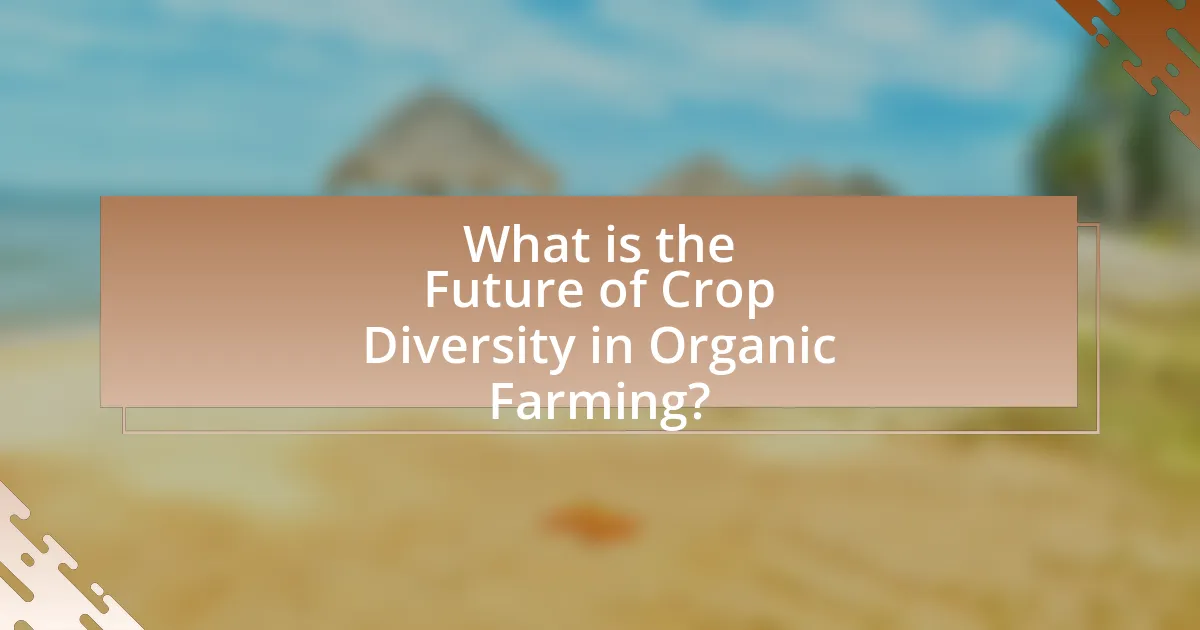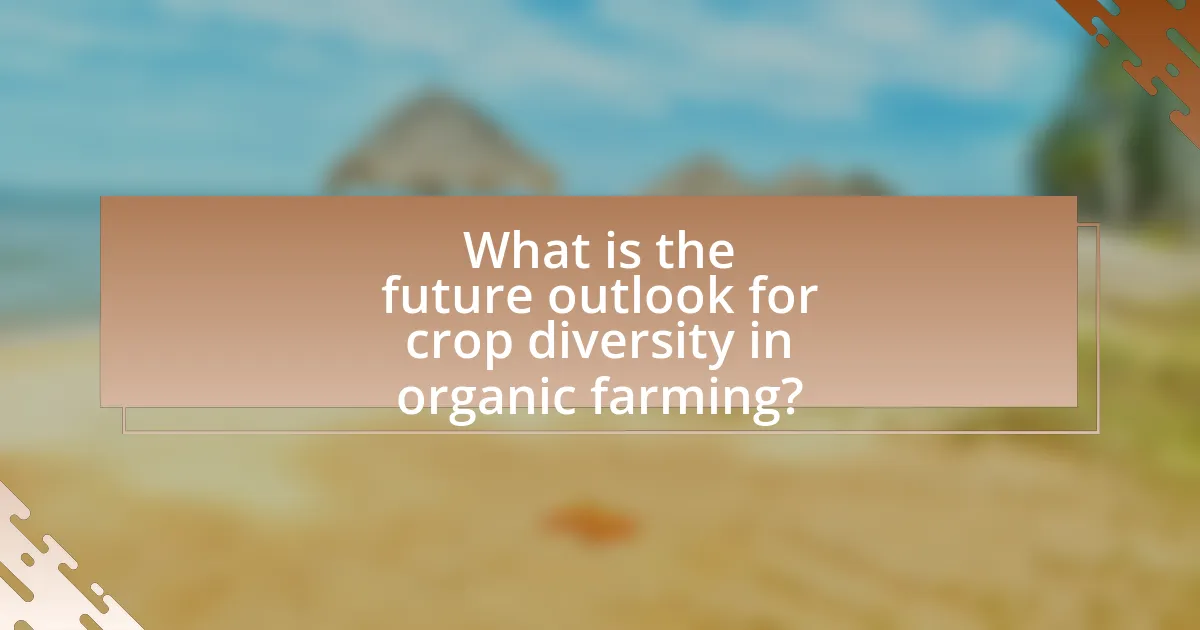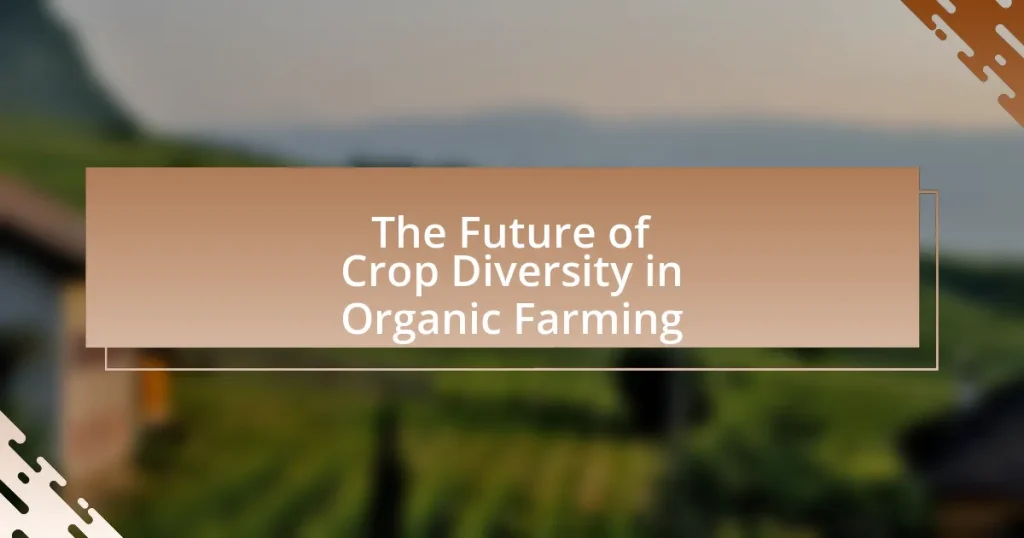The article focuses on the future of crop diversity in organic farming, highlighting its significance in enhancing resilience against pests, diseases, and climate change. It discusses how diverse cropping systems improve soil health, increase yields, and contribute to sustainable agricultural practices. Key components of crop diversity, such as genetic, species, and ecosystem diversity, are examined, along with the benefits of practices like crop rotation and intercropping. The article also addresses challenges faced by farmers, including economic barriers and regulatory frameworks, while emphasizing the role of technological advancements and genetic research in promoting crop diversity for sustainable farming.

What is the Future of Crop Diversity in Organic Farming?
The future of crop diversity in organic farming is expected to expand significantly due to increasing consumer demand for diverse and sustainable food options. Research indicates that diverse cropping systems enhance resilience against pests, diseases, and climate change, which is crucial as organic farming practices aim to improve soil health and biodiversity. A study published in the journal “Agriculture, Ecosystems & Environment” by authors such as Altieri and Nicholls highlights that diversified organic systems can lead to higher yields and improved ecosystem services. This trend is supported by initiatives promoting agroecological practices, which emphasize the importance of crop diversity for sustainable agricultural development.
How does crop diversity impact organic farming practices?
Crop diversity significantly enhances organic farming practices by improving soil health, pest management, and crop resilience. Diverse crops contribute to a more balanced ecosystem, which reduces the reliance on synthetic inputs and promotes natural pest control mechanisms. For instance, studies have shown that farms with higher crop diversity experience lower pest populations and increased pollinator activity, leading to better yields. Additionally, crop rotation and intercropping, common practices in organic farming, leverage diversity to enhance nutrient cycling and soil structure, ultimately resulting in sustainable agricultural systems.
What are the key components of crop diversity in organic farming?
The key components of crop diversity in organic farming include genetic diversity, species diversity, and ecosystem diversity. Genetic diversity refers to the variety of genetic information within a species, which enhances resilience to pests and diseases. Species diversity involves cultivating multiple crop species, which can improve soil health and reduce reliance on chemical inputs. Ecosystem diversity encompasses the variety of habitats and ecological processes that support agricultural systems, promoting beneficial interactions among crops, soil, and wildlife. These components collectively contribute to sustainable agricultural practices, as evidenced by studies showing that diverse cropping systems can lead to higher yields and improved ecosystem services.
How does crop diversity contribute to soil health and fertility?
Crop diversity significantly enhances soil health and fertility by promoting a balanced ecosystem that supports various soil organisms. Different crops contribute unique organic matter and nutrients to the soil, improving its structure and nutrient-holding capacity. For instance, legumes fix nitrogen in the soil, which benefits subsequent crops, while deep-rooted plants can access nutrients from deeper soil layers, making them available to other plants. Research indicates that fields with diverse crops can have up to 30% higher soil organic matter compared to monoculture systems, leading to improved soil fertility and resilience against erosion and degradation.
Why is crop diversity important for sustainable agriculture?
Crop diversity is crucial for sustainable agriculture because it enhances ecosystem resilience, improves soil health, and increases crop yields. Diverse crops can better withstand pests, diseases, and climate variability, reducing the need for chemical inputs. Research indicates that farms with higher crop diversity can yield up to 20% more than monoculture systems, as shown in a study published in the journal “Nature” by Tilman et al. (2014). This increased resilience and productivity contribute to long-term agricultural sustainability and food security.
What role does crop diversity play in pest and disease management?
Crop diversity plays a crucial role in pest and disease management by enhancing ecosystem resilience and reducing the prevalence of pests and diseases. Diverse cropping systems create a variety of habitats that can support beneficial organisms, such as predators and parasitoids, which help control pest populations. Research indicates that farms with higher crop diversity experience lower pest incidence; for instance, a study published in the journal “Agriculture, Ecosystems & Environment” found that polycultures can reduce pest damage by up to 50% compared to monocultures. Additionally, crop diversity can disrupt pest life cycles and reduce the spread of diseases by limiting the availability of host plants. This multifaceted approach not only promotes sustainable farming practices but also contributes to higher yields and improved soil health.
How does crop diversity enhance resilience to climate change?
Crop diversity enhances resilience to climate change by increasing ecosystem stability and reducing vulnerability to pests and diseases. Diverse cropping systems can better withstand extreme weather events, such as droughts and floods, because different crops have varying tolerances and growth patterns. For instance, a study published in the journal “Nature” found that farms with higher crop diversity experienced 20% less yield loss during climate extremes compared to monoculture farms. This resilience is further supported by the fact that diverse crops can improve soil health and nutrient cycling, which are critical for maintaining productivity under changing climate conditions.
What challenges does crop diversity face in organic farming?
Crop diversity in organic farming faces significant challenges, primarily due to pest and disease pressures, limited genetic resources, and market demand for uniformity. Pest and disease pressures can lead to reduced yields and increased reliance on organic pesticides, which can undermine the principles of organic farming. Limited genetic resources restrict the ability of farmers to select diverse crop varieties that are resilient to changing environmental conditions. Additionally, market demand often favors uniformity in crop appearance and quality, discouraging farmers from cultivating a diverse range of crops. These challenges highlight the need for strategies that promote crop diversity while addressing the economic and ecological aspects of organic farming.
What are the economic barriers to implementing crop diversity?
The economic barriers to implementing crop diversity include high initial costs, market demand limitations, and the risk of reduced yields. High initial costs arise from the need for investment in diverse seeds, equipment, and training for farmers. Market demand limitations occur when consumers prefer monocultures, leading to lower profitability for diverse crops. Additionally, the risk of reduced yields can deter farmers from diversifying, as they may fear that unfamiliar crops will not perform as well as traditional ones. According to a study by the Food and Agriculture Organization, farmers often face a trade-off between short-term economic stability and long-term sustainability when considering crop diversity.
How do regulatory frameworks affect crop diversity in organic farming?
Regulatory frameworks significantly influence crop diversity in organic farming by establishing guidelines that dictate which crops can be cultivated and how they must be managed. These regulations often prioritize certain species or varieties that meet organic certification standards, which can limit the range of crops that farmers may choose to grow. For instance, the USDA Organic Regulations in the United States require that organic crops be grown without synthetic pesticides or fertilizers, which can affect the selection of crop varieties that are resilient to pests and diseases. Consequently, this can lead to a reduction in genetic diversity as farmers may opt for a narrower range of crops that are compliant with these regulations. Studies have shown that regions with stringent organic regulations often exhibit lower crop diversity compared to those with more flexible frameworks, highlighting the direct correlation between regulatory policies and the biodiversity of organic farming systems.

How can farmers enhance crop diversity in their practices?
Farmers can enhance crop diversity in their practices by implementing crop rotation, intercropping, and selecting a variety of plant species suited to their local environment. Crop rotation involves alternating different crops in the same field across seasons, which helps improve soil health and disrupt pest cycles. Intercropping, the practice of growing two or more crops in proximity, can increase biodiversity and reduce the risk of crop failure. Additionally, selecting diverse plant species can lead to improved resilience against diseases and climate variability. Research indicates that farms with higher crop diversity can yield better overall productivity and sustainability, as evidenced by studies showing that diverse cropping systems can increase yields by up to 20% compared to monocultures.
What strategies can be employed to increase crop diversity?
To increase crop diversity, farmers can implement crop rotation, intercropping, and the use of cover crops. Crop rotation involves alternating different crops in the same field across seasons, which helps break pest and disease cycles while improving soil health. Intercropping, the practice of growing two or more crops in proximity, enhances biodiversity and can lead to better pest control and resource use efficiency. The use of cover crops, which are planted during off-seasons, protects soil from erosion, improves soil fertility, and increases biodiversity by providing habitat for beneficial organisms. Research indicates that these strategies can significantly enhance ecosystem resilience and productivity in organic farming systems.
How can intercropping and crop rotation improve diversity?
Intercropping and crop rotation enhance biodiversity by promoting a variety of plant species and improving soil health. Intercropping involves growing different crops in proximity, which can lead to increased competition for resources, pest suppression, and enhanced pollinator activity. Crop rotation, on the other hand, involves alternating different crops in a specific sequence over time, which helps break pest and disease cycles, reduces soil nutrient depletion, and fosters a more diverse microbial community in the soil. Research indicates that these practices can lead to a 20-30% increase in crop yield stability and a significant reduction in the need for chemical inputs, thereby supporting ecological balance and resilience in farming systems.
What role do heirloom and native varieties play in crop diversity?
Heirloom and native varieties are crucial for enhancing crop diversity by preserving genetic diversity and promoting resilience in agricultural systems. These varieties often possess unique traits that allow them to adapt to local environmental conditions, which is essential for maintaining biodiversity. For instance, heirloom tomatoes exhibit a wide range of flavors, colors, and resistance to pests, contributing to a more diverse gene pool. Research indicates that maintaining a diverse array of crops can improve ecosystem stability and food security, as demonstrated by studies showing that diverse cropping systems are more resilient to climate change and disease outbreaks.
What are the benefits of adopting diverse cropping systems?
Adopting diverse cropping systems enhances agricultural resilience, improves soil health, and increases biodiversity. These systems reduce the risk of crop failure by spreading the risk across multiple species, which can adapt to varying environmental conditions. Research indicates that diverse cropping can lead to improved nutrient cycling and pest management, as different crops can support beneficial organisms and reduce the prevalence of pests. For instance, a study published in the journal “Agriculture, Ecosystems & Environment” found that farms practicing crop diversity had 30% higher yields compared to monoculture systems, demonstrating the tangible benefits of this approach.
How does crop diversity improve yield stability?
Crop diversity improves yield stability by enhancing ecosystem resilience and reducing vulnerability to pests and diseases. When multiple crop species are cultivated together, they can utilize resources more efficiently and create a more balanced ecosystem, which mitigates the risk of total crop failure. Research indicates that diverse cropping systems can lead to a 20-30% increase in yield stability compared to monocultures, as demonstrated in studies conducted by the University of California, Davis, which found that polycultures can buffer against environmental stresses such as drought and nutrient fluctuations. This increased resilience is crucial for sustainable agricultural practices, particularly in organic farming, where reliance on chemical inputs is minimized.
What environmental benefits arise from increased crop diversity?
Increased crop diversity leads to enhanced soil health, improved pest and disease resistance, and greater resilience to climate change. Diverse cropping systems promote a variety of root structures and organic matter, which improve soil structure and fertility. Research indicates that farms with higher crop diversity can reduce the need for chemical fertilizers and pesticides, as diverse plants can naturally suppress pests and diseases. For instance, a study published in the journal “Nature” found that diversified cropping systems can increase yields by up to 20% while reducing the reliance on synthetic inputs. Additionally, diverse crops can better withstand extreme weather events, contributing to agricultural sustainability in the face of climate change.

What is the future outlook for crop diversity in organic farming?
The future outlook for crop diversity in organic farming is promising, driven by increasing consumer demand for diverse and sustainable food options. Research indicates that organic farming systems that prioritize crop diversity can enhance ecosystem services, improve soil health, and increase resilience to climate change. For instance, a study published in the journal “Agriculture, Ecosystems & Environment” found that diverse cropping systems can lead to higher yields and reduced pest pressures compared to monocultures. As organic farming practices evolve, the integration of diverse crop rotations and polycultures is expected to become more prevalent, further supporting biodiversity and sustainable agricultural practices.
How are technological advancements influencing crop diversity?
Technological advancements are significantly influencing crop diversity by enabling the development of new crop varieties and improving agricultural practices. Innovations such as genetic engineering, precision agriculture, and data analytics allow farmers to cultivate a wider range of crops that are more resilient to climate change, pests, and diseases. For instance, the use of CRISPR technology has led to the creation of drought-resistant varieties, which can thrive in arid conditions, thereby enhancing the genetic diversity of crops available for cultivation. Additionally, precision agriculture techniques, which utilize satellite imagery and soil sensors, help farmers optimize planting strategies and manage diverse crop rotations effectively, promoting biodiversity in farming systems. These advancements not only increase the resilience of agricultural systems but also contribute to sustainable farming practices by reducing reliance on chemical inputs and enhancing ecosystem health.
What role does genetic research play in enhancing crop diversity?
Genetic research plays a crucial role in enhancing crop diversity by identifying and utilizing genetic variations within plant species. This research enables the development of new crop varieties that are more resilient to diseases, pests, and changing environmental conditions. For instance, studies have shown that genetic markers can be used to select for traits such as drought tolerance and nutrient efficiency, which are essential for sustainable agriculture. Furthermore, the International Rice Research Institute has documented that genetic diversity in rice varieties can lead to improved yields and better adaptation to climate change, demonstrating the tangible benefits of genetic research in promoting crop diversity.
How can data analytics support crop diversity initiatives?
Data analytics can support crop diversity initiatives by enabling farmers and researchers to analyze large datasets related to soil health, climate conditions, and crop performance. This analysis helps identify which crop varieties are best suited for specific environments, thereby promoting biodiversity. For instance, a study published in the journal “Agricultural Systems” found that data-driven approaches can increase crop yields by up to 30% while enhancing genetic diversity. By utilizing predictive modeling and machine learning, stakeholders can make informed decisions on crop selection and rotation strategies, ultimately fostering a more resilient agricultural ecosystem.
What best practices can farmers adopt for successful crop diversity?
Farmers can adopt several best practices for successful crop diversity, including crop rotation, intercropping, and the use of cover crops. Crop rotation helps prevent soil depletion and reduces pest and disease cycles by alternating different crops in the same field over time. Intercropping, which involves growing two or more crops in proximity, can enhance biodiversity and improve yields by maximizing resource use and minimizing competition. The use of cover crops, such as legumes, enriches soil health and prevents erosion while providing habitat for beneficial organisms. Research indicates that farms practicing diverse cropping systems can achieve up to 20% higher yields compared to monoculture systems, demonstrating the effectiveness of these practices in enhancing agricultural sustainability and productivity.
How can farmers assess their current crop diversity levels?
Farmers can assess their current crop diversity levels by conducting a comprehensive inventory of the different crop species and varieties grown on their farms. This assessment involves cataloging each crop type, noting the number of varieties, and evaluating the genetic diversity within those varieties. Research indicates that farms with higher crop diversity can enhance ecosystem resilience and improve soil health, which is critical for sustainable organic farming practices. For instance, a study published in the journal “Agriculture, Ecosystems & Environment” found that farms with diverse cropping systems had better pest control and reduced disease incidence, demonstrating the benefits of maintaining crop diversity.
What resources are available for farmers looking to diversify their crops?
Farmers looking to diversify their crops can access various resources, including agricultural extension services, online databases, and local cooperative programs. Agricultural extension services provide expert advice and research-based information tailored to local conditions, helping farmers select suitable crops for diversification. Online databases, such as the USDA’s National Agricultural Statistics Service, offer data on crop performance and market trends, enabling informed decision-making. Additionally, local cooperatives often provide workshops, seed exchanges, and networking opportunities, fostering collaboration among farmers to share best practices and resources for crop diversification.










